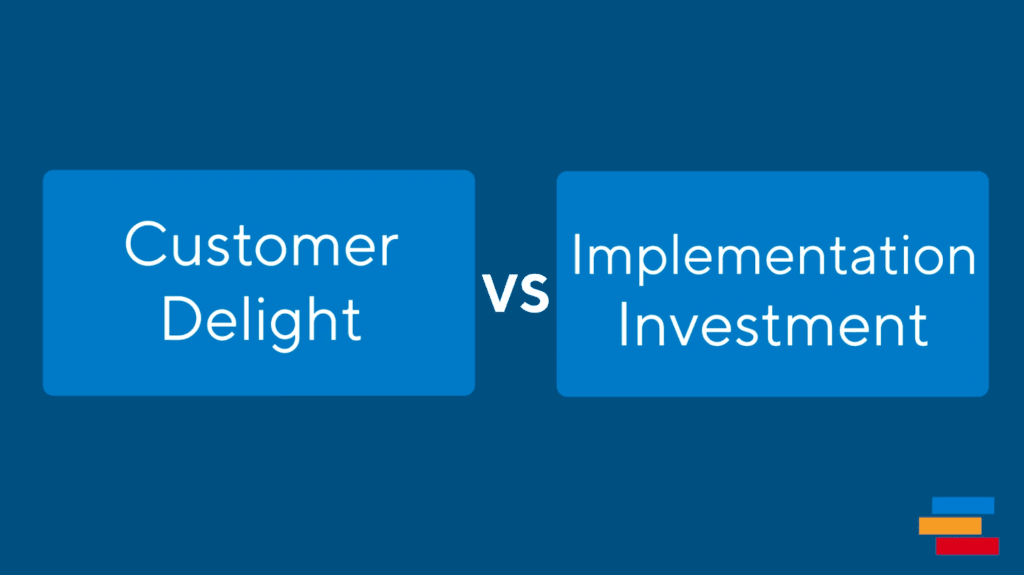No product is too dull for excitement features. No matter your product, there’s always a way to add excitement and customer delight. Today we’ll share examples of excitement features in everyday products and help you find ways to add excitement to your own products.
What are excitement features?
Excitement features are one of the 4 categories of features addressed in the Kano model. The Kano model is frequently used as a tool for prioritizing product initiatives. The prioritization model compares factors like time and resources needed to implement new features against the potential “customer delight” they may generate.

Research shows excitement features can create an outsized return on investment. And, for good reason. Done right, excitement features can turn average customers into loyal fans.
An example of excitement features in action
You might not consider a can of paint to be the type of product with a lot of room for exciting features. But the product team at Dutch Boy Paints did. They saw an opportunity to build an excitement feature right into their paint cans. And as a result, delighted customers and changed the business.
Here’s how it worked: While other paint makers focused on new colors and textures, Dutch Boy took a step back and examined the entire experience. They discovered customers hated dealing with paint cans. Prying open the metal top with a screwdriver, trying to pour out the paint without making a mess, and trying to reseal the lid so the paint wouldn’t dry out (which it did anyway) were all pain points.
For the Dutch Boy product team, the result of their research was the Twist & Pour® container. A first-of-its-kind paint can with a twist-off lid, a spout to help you control how much paint you poured out and to minimize spilling, and a handle on the side to make pouring and carrying easier.
And, when they saw that new container for the first time on the shelf of a home improvement store, everyone who’d ever had to paint a room in their home shouted, “Yeah!!!”
Now that’s the perfect example of excitement features in action.
As marketing author Seth Godin explains in his TED Talk about making your ideas spread, the Twist & Pour saved the Dutch Boy Paint company and made it a fortune.
So, what can you do to add excitement features to your products that will generate customer delight and maybe even make your company a fortune?
Does my product have the potential for excitement features?
Any product can add excitement features.
The iPhone X has amazing new photo capabilities. SpaceX is readying private trips to the moon for tourists. But, you don’t have to work for a multi-billion-dollar tech giant to build excitement features into your products. As our previous example of excitement features proves, you can get customers buzzing like crazy—and buying like crazy, too—even if your product is paint.
The key step to identifying a potential excitement feature is to step back and examine the whole customer experience.
One reason many companies miss out on excitement features is their focus is too narrow. They look only at the product itself and ask, “What else could we add here that would be cool?” The truth is, you’ll have much more difficulty identifying new features that delight your customers if you’re staring directly at the product. You need to step back and examine things from your customer’s point of view.
Dutch Boy took that step back. And they realized their customers weren’t interested in yet another set of new paint colors. They were interested in a different painting experience. The same is true for your company. It doesn’t matter how boring you think your products are. Step back and take that broader, customer-centric view. Chances are you’ll start seeing things your product team can improve.
Here are a few more examples of creative ways businesses capitalized on excitement features. Each example is from a completely different industry.
3 Examples of excitement features in everyday products
1. The no-haggle car price (Saturn Corporation)
When General Motors launched its car brand, Saturn, in the US, there shouldn’t have been much fanfare. It was, after all, just one more line of economy cars in the already crowded GM family. The cars themselves weren’t even very exciting—many people described them as bland.
But Saturn made a big name for itself and earned billions in sales. Why? It uncovered and developed a single excitement feature no other car company had ventured to try. The fixed, no-haggle sticker price.
Turns out that was an extremely welcome message to millions of people who hate buying cars. Many US Americans hated having to negotiate prices at the dealership and didn’t trust the sales reps.
Like Dutch Boy Paint, the team at Saturn stopped staring directly at their products looking for inspiration. Instead, they took a broader view of the entire car-buying process from their customers’ vantage point. They determined the best way of differentiating themselves was not by adding features to their cars but by making the buying experience less stressful and frustrating.
After a couple of decades, Saturn failed as a company. But not because of its fixed pricing model. In fact, for many years, Saturn enjoyed a unique advantage in the industry—and the loyalty of millions of car buyers—because of this one excitement feature.
2. The beef jerky packaged with dental floss (True Jerky)
Most beef jerky makers probably view product development through the same type of narrow lens that paint makers view their products. They put their efforts into creating new flavors, coming up with new messaging for their packaging, and other things like that. That is completely fine.
But the product team at True Jerky took that all-important step back. They asked a different question: “What happens to our customers after they’ve eaten some of our jerky?”
One common answer is that those customers find they have annoying bits of beef jerky stuck in their teeth. This can be frustrating, annoying, and even embarrassing if you’re out in public.
So these smart product professionals created a totally unexpected excitement feature. They placed a floss pick into every package of their product, visible from the outside. That means any shopper studying the gazillion beef jerky packages on the store shelves is going to notice something completely different when they reach the True Jerky section.
Even better, seeing that floss pick inside the bag triggers a similar, positive thought process for almost everyone who’s ever eaten beef jerky.
“Yeah, I’m going to get some of this stuff stuck in my teeth; what a great idea to give me a floss pick with the bag!”
So here’s yet another example of an excitement feature created because the team stepped back and looked at the entire customer experience.
3. The AppFolio Craigslist-automation widget (AppFolio)
ProductPlan Co-founder Jim Semick was also on the founding team of AppFolio, which makes cloud software for property managers.
In a short video on the Kano model, Jim describes a personal example from his time at AppFolio of finding an excitement feature that truly delighted customers and moved the needle for the company.
Jim and his AppFolio team understood the property managers who used the company’s software spent a lot of their time on Craigslist. They needed to post details about new rental units available. That was a tedious but necessary part of a property manager’s daily tasks.
Rather than spend more development cycles adding functionality to AppFolio’s core accounting tools—which, as the Kano model indicated, would have yielded diminishing returns—the team chose to build a small widget. The widget automatically connected to Craigslist and could post rental information that the property manager had previously been entering manually.
And, of course, customer delight ensued! This was a true excitement feature because it removed a part of the job that property managers hated but had until then accepted as just a frustrating fact of life.
And—we’ll say it one more time—Jim and his team identified this excitement feature because they took that all-important broader view of the customer experience and found a way to make it better.
How to approach adding excitement features
Product teams overseeing any type of product in any industry have the ability to develop and prioritize excitement features. You just have to know where to look to find them. Here are the three steps of ideating excitement features.
- Step back and look beyond your product itself to the entire user experience.
- Look for aspects of that user experience that are flawed, could be frustrating, or aren’t as efficient as they could be.
- Finally, do something bold. Something your customer isn’t expecting. Something to surprise and delight them.




